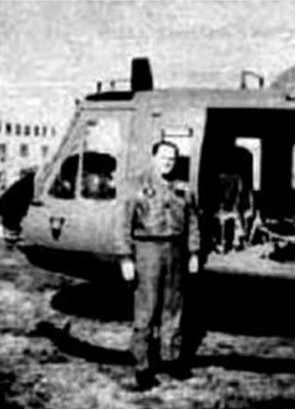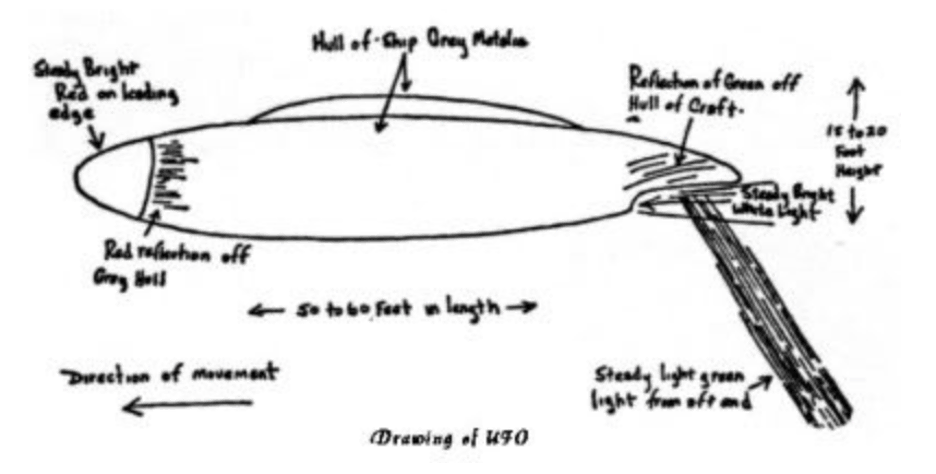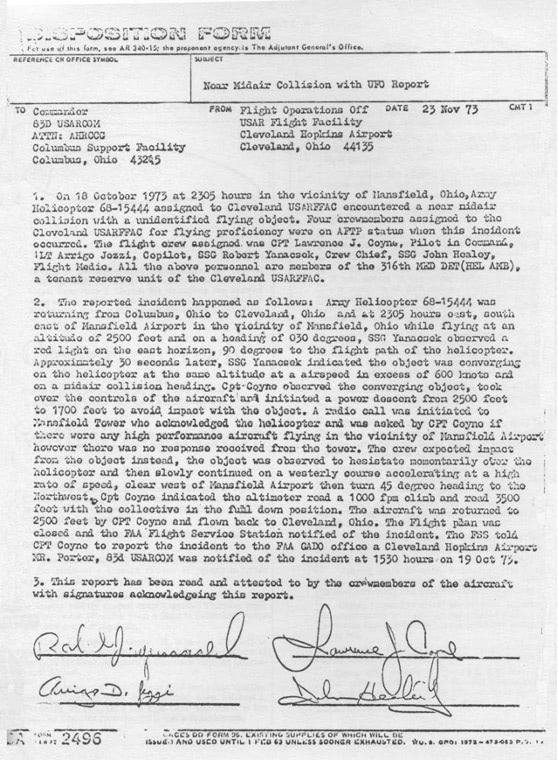Summary

The Coyne Incident, also known as the Coyne Encounter or Mansfield Incident, was a reported event that took place in 1976, where Captain Lawrence J. Coyne and a crew of three US army servicemen were allegedly intercepted mid-air by an unknown craft. The reported interception took the crew’s aircraft 1,500ft above its intended flight path – in a matter of seconds. The crew’s experience was reported widely at the time – and has been ever since – by American media, but UAP skeptics have put forward other theories of what could have happened that night, ensuring the event continues to stir up interest almost 50 years later.
An Ordinary Journey
Captain Coyne was a 39-year-old military commander and Army Reserve helicopter pilot with 19 years of flying experience¹ flying a routine day trip to Columbus from Cleveland, Ohio on October 18, 1973. He was piloting an Army Reserve UH-1, known as a “Huey”, along with a three man crew. The flight left Port Columbus at roughly 10.30pm, traveling towards Cleveland Hopkins airport at approximately 96 nautical miles to the north-northeast.
Seated in the left-front seat was 1st Lieutenant Arrigo Jezzi, a 26-year-old chemical engineer seated at the helicopter's controls. Behind Lieutenant Jezzi was Sergeant John Healey, 35, a Cleveland policeman and flight medic, who was the craft’s crew chief. Also present was Sergeant Robert Yanacsek, 23 years old, and a computer technician.²
The squadron was flying through a clear, starry and moonless sky, cruising at 90 knots and 2.500ft,³ flying above a mix of hills, woods, and rolling farmland.

Strange Red Light
Around 11 p.m., 10 miles south of Mansfield, Sergeant Healey noticed a single red light to the west, flying south. Within minutes, Sergeant Yanacsek reported a single red light to the southeast horizon. Captain Coyne noted the light and told Sergeant Yanacsek to “keep an eye on it”.⁴
The crew assumed it was a tower beacon or aircraft port wing light until it turned toward the helicopter and began a rapid approach around 30 seconds after Sergeant Yanacsek first noticed it.
The light closed in on the Huey, seemingly on a collision path. According to a later report written by Captain Coyne, the light was traveling in excess of 600 knots, and came from the horizon to the aircraft in “about 10 seconds”.⁵ ⁶ Captain Coyne immediately took the controls and began an evasive, steep descent of 500 feet per minute,⁷ steeling himself for impact with the other craft, which was now approaching from the right hand side. Despite Captain Coyne’s nosedive, the crew was still unable to outmaneuver the object. The crew contacted the National Guard aircraft tower in Mansfield to check if the approaching craft was ‘friendly’, but after an initial contact to Mansfield Tower base of “This is Mansfield Tower, go ahead Army 1-5-triple-4”, all communication was lost.
Lieutenant Jezzi then attempted transmission on both UHF and VHF frequencies without success. Although the channel and keying tones were both heard, there was no response from the Mansfield tower.
At 1,700ft, as the crew braced itself for impact, the light halted, and slowed, but continued to keep pace with the Huey, alternating between appearing above and in front of the helicopter.
An Inexplicable Experience
In Captain Coyne’s later report, he described looking up at the red light and seeing it had stopped right over the helicopter:
“It had a big, gray metallic-looking hull about 60 feet long. It was shaped like an airfoil or a streamlined fat cigar. There was a red light on the front. The leading edge glowed red a short distance back from the nose. There was a center dome. A green light at the rear reflected on the hull."I

Captain Coyne said the green light swiveled like a spotlight and beamed through the canopy of his craft, bathing the cabin in green light. He said as he and members of the crew stared at the craft, his helicopter began to climb without his guidance:
“I had made no attempt to pull up. All controls were set for a 20-degree dive. Yet we had climbed from 1,700 to 3,500 feet with no power in a couple of seconds with no g-forces or other noticeable strains."
The object then abruptly stopped whatever it had been doing to the helicopter and shot off towards the west, leaving the crew and their craft behind. It then executed a sharp 45 degree turn and raced over Lake Erie, speeding away.
The crew checked the altimeter and were shocked to find they were at 3,500ft and climbing, but the collective was still in the full down position, and the magnetic compass was malfunctioning.
An article in the November 4, 1973 edition of the Mansfield News Journal, written by a United Press International reporter, described Captain Coyne as a “military commander who doesn’t believe in unidentified flying objects or little green spacemen.” The article continued:
“But after a near miss two weeks ago between his helicopter and a ‘big, gray, metallic-looking’ object in the sky over Mansfield, he doesn't know what to think. ‘I had to file an official report in detail to the Army on this thing,’ he said.”
He told the paper he had been “scared”. Lieutenant Jezzi later told the same paper that: “The first thing I thought was those Commie bastards…what are they up to?”

Captain Coyne later contacted the Mansfield National Guard Tower, where he had radioed in during the incident, but they had no records whatsoever of any contact with him or his crew on that evening. Officials at the National Guard also confirmed there were no other aircraft in the area at that time.
Maintenance crews later attempted to fix the magnetic compass that broke during the incident, but eventually had to remove the entire unit and replace it completely, as they were unable to find out what was wrong with it.
Other Witnesses
Seven other witnesses on the ground were subsequently located and reported they had watched the Huey and the UAP in close proximity and had seen them separate. In a soybean field on the west side of Galion, Rene Boucher and her brother Brad had encountered a bright light in the sky. Speaking to the Mansfield News Journal for a 2003 anniversary article of the Coyne Incident, Rene said:
"I was in high school. My brother was in junior high. There had been a lot of sightings in the days and weeks before that. Even the governor reported seeing something. We thought we'd give it a try."
Rene and her brother walked out into the soybean field behind their home and began watching the sky:
"We saw a bunch of stuff that looked like it was maybe 30,000 feet in the air. But it wasn't anything spectacular. Then I think we both put our heads down for some reason. That's when we saw this brilliant white light. It was as bright as the sun. I don't know what it was but it scared us. We ran for two blocks until we got home."
Another group of ground witnesses were found by independent UFO researchers William E. Jones and Warren Nicholson; Mrs E.C. and four adolescents who were driving south from Mansfield to their rural home at around 11pm.⁸ They noticed a single, steady bright red light flying south at a “medium altitude”. They watched for roughly half a minute until it disappeared to the south over the trees. Approximately five minutes later, the family witnessed two lights, one red and one green, descending rapidly towards them. The female driver of the car, Mrs E.C., pulled over and kept the engine and car lights running. The two lights moved towards the right of the car and the family then became aware of another group of lights, some of them flashing, as well as a “beating sound, a lot of racket”. Two of the children, both aged 13, jumped out of the car and observed a helicopter, and a UAP, which they described as being “as big as a school bus”, “pear shaped” and “like a blimp”. The object hovered over the helicopter and its green light flared up. The witnesses described the lights as “like rays coming down”. The kids ran back into the car and Mrs E.C. sped off home.
Another witness, Terry Hamilton, was 15 years old riding home from Huron with his father when the pair saw what Hamilton describes as a “big ball of light”coming down from the sky and traveling parallel to the road before moving upward quickly out of sight.⁹
Coyne's Reports
The four men reported the incident in detail in the following days and even years to media, as well as issuing a statement in a document called “Operational Hazard Report”, which was signed by Lieutenant Jezzi on October 28, 1973, and included the description: “It was cigar shaped, a metallic gray body with a dome on top "(Operational Hazard Report," signed on Oct 28, 1973), "a highly intense white-green trailing light."
Another statement was issued from FAA Operations Chief at the time, PJ Vollmer, which read: “The helicopter was in an area without radar coverage at the time, he was picked up on radar (further north by Cleveland). But at no time did anyone pick up the other aircraft."
The military did not prevent the four pilots from speaking out about their experiences, and Captain Coyne even appeared at the United Nations in 1978, recounting the experience under the sponsorship of Grenada. He and his crew later won the National Enquirer Blue Ribbon Panel award, worth $5,000, for “The most scientifically valuable report of 1973”.¹⁰
Controversy
Although Captain Coyne was a respected official, there have been numerous doubts cast on his story, and alternative theories offered to explain away the incident of 1973. Philip Klass, author of UFOs: The Public Deceived, maintains that the object was a “fireball of the Orionid meteor shower”.¹¹ But this theory has been rejected by other researchers, such as those at the National UFO Reporting Center (NUFORC), an organization which catalogs UAP sightings, and the Center for UFO Studies, a privately funded UAP research group, which states:
“Any theory of the object's being a meteor…can readily be rejected on the basis of: (1) the duration of the event (an estimated 300 seconds); (2) the marked deceleration and hard-angle maneuver of the object at closest approach; (3) the precisely defined shape of the object; and (4) the horizon-to-horizon flight path.”¹²
Klass, who is known for his skepticism regarding UAPs, also analyzed the crew’s attempts to radio to the Mansfield National Guard Tower, and other airports. Captain Coyne had claimed the UAP had caused the helicopter’s radio to stop working for several minutes, making it impossible to contact Cleveland, Columbus and Akron airports. In his Volume 53 issue of his SUN newsletter, published on September 1, 1998, he wrote:
“My investigation indicated a more prosaic explanation: that at the helicopter’s then-low-altitude it was beyond line-of-sight range to these airports. I suggested that Coyne conduct an experiment during his next flight to Columbus—that near Mansfield he descended to the same low altitude and try to make radio contact with these same airports. Coyne ran such a test and later informed me that he was unable to reach any of the three airports, as I had predicted.”¹³
There is no available evidence to prove Coyne ever ran the tests that Klass describes. A decade earlier, Jennie Zeidman, an associate of astronomer J Allen Hynek, published a report titled ‘Helicopter-UFO Encounter Over Ohio’ for the Centre for UFO Studies after meticulously investigating the case. She noted that Lieutenant Jezzi had been repeatedly trying to contact Mansfield:
“He tried on both UHF and VHP. The frequency change tones are duly noted. The channels did change. ‘But then there was nothing,’ Coyne said. ‘And yet the radio worked, because we were talking to Mansfield just before, without a change, and we were able to contact Akron Approach after.’ It should be noted that the helicopter was not below radio range of Mansfield airport. The airport elevation is 1297 ft; during the attempted transmissions the helicopter was in line of sight, and approximately 10 miles away.”
Other theories speculate that a mid air refueling craft was likely responsible for what Captain Coyne and the eyewitnesses saw.¹⁴
Conclusion
The Coyne incident is unusual as it involves not only a crew of military officers but a number of independent ground eyewitnesses. What the UAP really was that night in 1973 has never been resolved. Richard Haines, a retired senior research scientist for the NASA-Ames Research Center in California, started the National Aviation Reporting Center on Anomalous Phenomena, or NARCAP, to give pilots and air traffic controllers a confidential place to report their own unusual sightings of UAP. Haines ranks the Coyne case “very, very high in credibility, telling The Huffington Post:
“One reason is Coyne's reputation as a good pilot before this happened. And his courage -- the fact that he was willing to come forward with this very bizarre story and to stand by it says an awful lot. And he would give encouragement to other pilots to do the same. If everybody remains silent, we're never going to get to the bottom of this."¹⁵